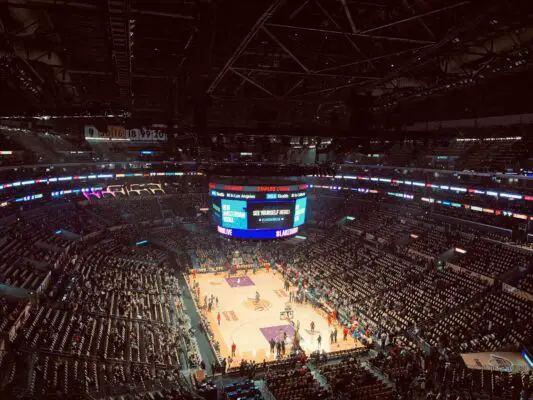While the playoffs don’t have much of an impact on conferences in the National Basketball Association, it has an impact on a number of other things. The biggest thing the divisions have an impact on is the schedule.
Why do schedules matter? It has an impact on how many times teams will play each other during the season and can also affect how easy or difficult a team’s schedule is.
So if the NBA gets rid of conferences altogether, which there has been some talk about doing what would the NBA have to figure out? While obviously, they would have to figure out how else to configure the schedule for the regular season, it could have a negative impact on many other things.
So onto the next subject.
Why are divisions beneficial?
Currently, the NBA benefits from having divisions because most of the time the teams are close together geographically which allows for a lesser need for teams to have a larger travel budget and it also reduces the impact on players’ bodies cause let’s face it. Even for those who aren’t athletes if you have to make many long distance flights every year it’s going to take a toll on their bodies.
So which conferences benefit more from the current scheduling system you may ask? It’s actually the opposite of what you may think. The teams that are in more competitive divisions are at an advantage because they play each other less than those outside of their division.
During the regular season, NBA teams play all of the other conference opponents four teams during the season which make up for 16 out of their 82 games which makes up for 38 percent of the season.
So what about everybody outside the division?

While NBA teams play their division opponents four times during the season, this doesn’t mean that there isn’t a specific number of times that they don’t play other teams outside of their division but are still inside their conference a specific number of times during the season.
Teams also play six other teams that are not in their division but are in their conference four times and after that, they will play three games apiece against the other four teams that are in their conference. For the season each time plays 41 home games and 41 away games total.
There are six divisions in total, three from the east and three from the west.
Now on to the subject of the competitiveness of each division.
Eastern Conference
1. Atlantic division
Historically the 76ers and Celtics have been in the biggest rivalry coming out of this division as both teams come from historical cities (Philadelphia and Boston) and are fairly competitive. This division does contain the team which represented the east in the finals in the 2021-2022 season (Celtics, who lost to Golden State in the finals).
The Nets, Knicks, and Raptors have all had their moments in recent years but are all under .500 at the moment and the teams have 23 championships combined, 17 of which came from the Boston Celtics.
2. Central division
This division has been one of the more competitive divisions over the last 40 years. The biggest rivalry that has come out of the central division is between the Detroit Pistons and Chicago Bulls during the 80s and 90s.
During the time they were rivals they combined for eight championships (the Bulls had six championships while the Pistons had two. These were during the years that Chicago had Michael Jordan and Scottie Pippen while the Pistons had the “bad boys” i.e Dennis Rodman, Bill Laimbeer, Isaiah Thomas, and company.
In the current central division, the Bucks are the dominant team, and assuming that they keep their core that isn’t likely to change.
The Central division has 13 championships but the difference between this division compared to others is that the championships are a lot more spread out compared to other divisions. Six of the 13 came from the Chicago Bulls won six, the Pistons three and the Bucks won twice
3. Southeast division
Of the six divisions, the southeastern division by far has had the least success but a part of that could be because a lot of the teams in this conference are relatively new.
The Atlanta Hawks are the only team in this division that has a history that goes before the late 80s to early 1990s (1969 to be more exact) and historically has not been very competitive. They have five NBA championships over the team’s various histories.
Western Conference
 1. Northwest division
1. Northwest division
This Branch of the western conference is not one that is incredibly competitive. For the 2022-2023 season, as of January 1, only two of the five teams are above the 500 mark.
Those two teams are the Denver Nuggets who have recorded a 23-12 record along with the Portland Trailblazers who are at 18-17. Between the five teams, there have only been one NBA finals when the Oklahoma City Thunder made the finals in 2012 but bowed out to the Miami Heat in five games.
2. Pacific division
The Pacific division is interesting in a way as four out of the five teams are from California. Those are the Sacremento Kings, Golden State Warriors who play in Oakland, along with the Lakers and Clippers.
The Pacific division is a bit upside down this year compared to what it usually is in terms of who is actually winning the division.
The Lakers, who have a storied history in the NBA are currently in last place at 15-21 while the defending NBA champion Golden State Warriors are only a game above 500 at 19-18. The Pacific division has 19 NBA championships all time, 17 of which have came from the Lakers and Warriors, who have won 12 and 5 championships respectively.
3. Southwest division
Ever since 2000 this division has consistently had teams in either the Western Conference or NBA finals, most of which have come from the Mavericks, Spurs and Rockets. However, as the stars from those teams have had to be replaced due to age, New Orleans and Memphis have promise to be forces in the future.
The Southwest division has four championships, three of which came from the Spurs and one from the Dallas Mavericks. So what could happen if we completely get rid of the divisions? One question to ask ourselves.
If the NBA chooses to do away with the divisions who is the most likely to get hurt?

While it’s hard to say for sure unless we actually see it in action, more than likely it could be the players. Why?
There won’t be as much structure with the actual schedule which can increase the possibility for longer travel times and while the latter is less likely to be true, it potentially could ruin some rivalries.
For example with the Celtics and 76ers would it be more fun to say that they are just eastern conference rivals or Atlantic Division rivals? While the eastern conference may have the greater significance it would probably be agreed by most that more people would like to hear more that they are Atlantic Division rivals than they are just eastern conference rivals. Now on to the playoffs.
So if the divisions get completely scrapped then how will the schedule be determined in terms of who plays who how many times and so forth and how could that affect the playoffs? Well, the good news is that divisions aren’t actually affected by the playoff seeding.
While it’s hard to really predict exactly how it will affect the schedule, chances are the conferences will remain the same as the eastern and western conferences.
As of right now the way it works in the playoffs is the first six teams get an automatic bid into the playoffs and the teams that finish between seven and ten in the conference at the end of the season the four teams will have a play in a game and the top two teams will get awarded the seventh and eight seeds and will play the one and two seeds in the first round of the playoffs.






